Related Research Articles

Linear B is a syllabic script that was used for writing in Mycenaean Greek, the earliest attested form of the Greek language. The script predates the Greek alphabet by several centuries, the earliest known examples dating to around 1400 BC. It is adapted from the earlier Linear A, an undeciphered script potentially used for writing the Minoan language, as is the later Cypriot syllabary, which also recorded Greek. Linear B, found mainly in the palace archives at Knossos, Kydonia, Pylos, Thebes and Mycenae, disappeared with the fall of Mycenaean civilization during the Late Bronze Age collapse. The succeeding period, known as the Greek Dark Ages, provides no evidence of the use of writing.

The Minoan civilization was a Bronze Age culture which was centered on the island of Crete. Known for its monumental architecture and its energetic art, it is often regarded as the first civilization in Europe.
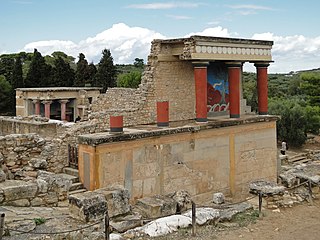
Knossos is a Bronze Age archaeological site in Crete. The site was a major center of the Minoan civilization and is known for its association with the Greek myth of Theseus and the minotaur. It is located on the outskirts of Heraklion, and remains a popular tourist destination.
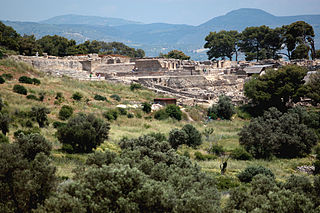
Phaistos ), also transliterated as Phaestos, Festos and Latin Phaestus, is a Bronze Age archaeological site at modern Faistos, a municipality in south central Crete. It is notable for the remains of a Minoan palace and the surrounding town.
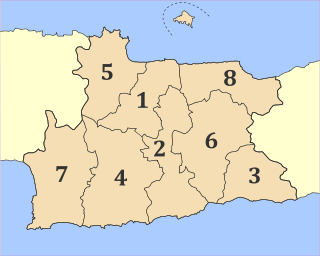
Heraklion is one of the four regional units of Crete. The capital is the city of Heraklion.

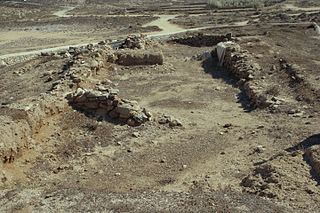
Ftelia is an archaeological site located on a beach on the island of Mykonos, Greece.

Vasiliki is the name of a village in the municipality of Ierapetra, in the prefecture of Lasithi, on Crete, and the name of the nearby Minoan archeological site. The site took its name from the village.

Amnisos, also Amnissos and Amnisus, is the current but unattested name given to a Bronze Age settlement on the north shore of Crete that was used as a port to the palace city of Knossos. It appears in Greek literature and mythology from the earliest times, but its origin is far earlier, in prehistory. The historic settlement belonged to a civilization now called Minoan. Excavations at Amnissos in 1932 uncovered a villa that included the "House of the Lilies", which was named for the lily theme that was depicted in a wall fresco.

Anemospilia is the archaeological site of an ancient Minoan temple on Crete.
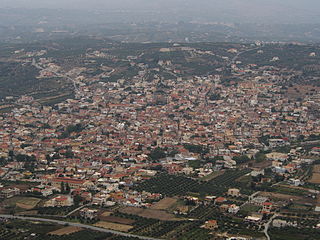
Archanes is a former municipality in the Heraklion regional unit, Crete, Greece. Since the 2011 local government reform it is part of the municipality Archanes-Asterousia, of which it is a municipal unit. The municipal unit has an area of 31.516 km2 (12.168 sq mi). Population 5,042 (2011). It is also the archaeological site of an ancient Minoan settlement in central Crete. The discovery of ancient roads leading from Archanes to Juktas, Anemospilia, Xeri Kara and Vathypetro indicate that Archanes was an important hub in the region during Minoan times. Archaeological evidence indicates that ancient Archanes spread out over the same area as the modern town of Archanes.


Kydonia or Cydonia was an ancient city-state on the northwest coast of the island of Crete. It is at the site of the modern-day Greek city of Chania. In legend Cydonia was founded by King Cydon (Κύδων), a son of Hermes or Apollo and of Akakallis, the daughter of King Minos. According to Pausanias he was son of king Tegeates.
Olous or Olus was a city of ancient Crete; now sunken, it was situated at the present day town of Elounda, Crete, Greece. According to the Stadiasmus Maris Magni, it had a harbour and was located 260 stadia from Chersonasus and 15 stadia from Camara.

Eleutherna, also called Apollonia (Greek: Ἀπολλωνία), was an ancient city-state in Crete, Greece, which lies 25 km southeast of Rethymno in Rethymno regional unit. Archaeologists excavated the site, located on a narrow northern spur of Mount Ida, the highest mountain in Crete. The site is about 1 km south of modern town of Eleftherna, about 8 km north east of Moni Arkadiou, in the current municipality of Rethymno. It flourished from the Dark Ages of Greece’s early history until Byzantine times.
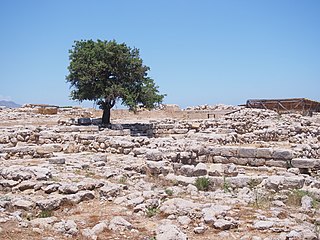
The Galatas Palace is a Minoan archaeological site on Crete discovered in the early 1990s. Built on a much older settlement, a Minoan palace was constructed in the early Neopalatial Period, sometime after 1700 B.C.E.. The palatial center was destroyed by an earthquake and abandoned later in the Postpalatial period, or around 1500 B.C.E.(LM IB)
The Kairatos is a natural watercourse on the island of Crete in Greece. In the Minoan era, aqueducts diverted water to Kephala hill from spring water sources at Archanes, which springs are the headwaters of the Kairatos River; in fact, the Bronze Age palace of Knossos lay upon the gently sloping banks of the Kairatos. The Kairatos runs east of Knossos and flows into the Aegean Sea in the Katsampas area, 1.5 km east of the city center of Heraklion.

MS Kydon Palace is a Greek Ro-Pax high speed ferry, built in 2001 at the Sestri Ponente shipyards by Fincantieri as Festos Palace for Minoan Lines' overnight services between Piraeus and Crete. Initially she ran to Heraklion. In 2020 she was transferred to the Piraeus–Chania route and renamed Kydon Palace She is a sister ship of Knossos Palace. She can reach speeds up to 30 knots. The ship's facilities include restaurants, bars and cabins.
Rhaucus or Rhaukos was a town of ancient Crete. From the story told about the Cretan bees by Antenor in his Cretica it seems that there were two cities of this name in Crete. The existence of two places so called in the island might give rise to some such legend as that which he mentions.

Minos Kalokairinos was a Cretan Greek businessman and amateur archaeologist known for undertaking the first excavations at the Minoan palace of Knossos. His excavations were later continued by Arthur Evans.
References
- ↑ Ancient Labyrinth, Crete
- ↑ C. Michael Hogan, Knossos fieldnotes, Modern Antiquarian (2007)
35°17′53″N25°09′45″E / 35.2980°N 25.1626°E